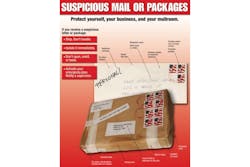Mitigating Mistakes: Don’t overlook the mailroom
Editor’s note: “Mitigating Mistakes” is a monthly SecurityInfoWatch.com column series from security consultant and author Paul Timm featuring photos of security vulnerabilities discovered in the field followed by a discussion on the problems they present to a facility’s security posture and how they can be addressed.
Finding: When conducting a security assessment, I always visit the mailroom or primary mail sorting area. Very rarely do I find the United States Postal Services (USPS) “Suspicious Mail or Packages” poster.
Problem: If an employee who is handling mail should encounter something suspicious (e.g. a mailpiece that is leaking or powdery, a package with excessive tape or postage), that person may not know what to do. If “handled” incorrectly, that person may potentially contaminate himself/herself and others. In a worst-case scenario, a violent blast could occur.
Lesson: Use tools like the USPS poster to equip and instruct employees. For example, if someone discovers a suspicious letter or package, that person should avoid contact. Immediately clear the area and call 911. Don’t let the improbability of this risk keep you from being prepared.
Remedy: Pursue and display loss prevention and emergency preparedness resources. Starting with the USPS poster, here are a few helpful and complimentary tools:
- https://about.usps.com/posters/pos84.pdf (Suspicious Mail or Packages)
- https://www.atf.gov/file/104816/download (Suspicious Packages & Bomb Threats)
- https://www.dhs.gov/see-something-say-something/campaign-materials (See Something, Say Something)
About the Author:
Paul Timm, Vice President of Facility Engineering Associates, is a board-certified Physical Security Professional (PSP), the author of School Security: How to Build and Strengthen a School Safety Program, and a nationally acclaimed expert in physical security. In addition to conducting numerous vulnerability assessments and his frequent keynote addresses, Paul is an experienced Crisis Assistance Team volunteer through the National Organization for Victims Assistance (NOVA). He is certified in Vulnerability Assessment Methodology (VAM) through Sandia National Laboratories and the ALPHA vulnerability assessment methodology. He is also a member of ASIS International’s School Safety & Security Council and the Illinois Association of School Business Officials’ Risk Management Committee. Paul recently earned his Master’s degree from Moody Theological Seminary.
About the Author

Paul Timm, PSP
President, RETA Security, Inc.
Paul Timm, Vice President of Facility Engineering Associates, is a board-certified Physical Security Professional (PSP), the author of School Security: How to Build and Strengthen a School Safety Program, and a nationally acclaimed expert in physical security. In addition to conducting numerous vulnerability assessments and his frequent keynote addresses, Paul is an experienced Crisis Assistance Team volunteer through the National Organization for Victims Assistance (NOVA). He is certified in Vulnerability Assessment Methodology (VAM) through Sandia National Laboratories and the ALPHA vulnerability assessment methodology. He is also a member of ASIS International’s School Safety & Security Council and the Illinois Association of School Business Officials’ Risk Management Committee. Paul recently earned his Master’s degree from Moody Theological Seminary.
